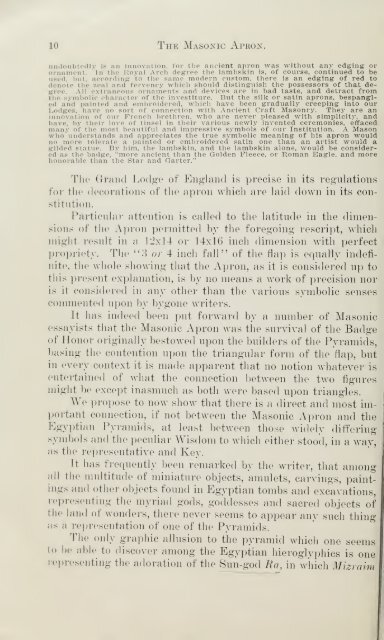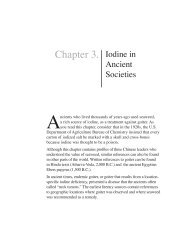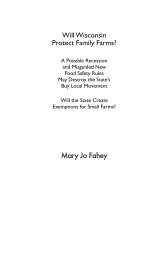The apron : its traditions, history and secret ... - Masonic Renewal
The apron : its traditions, history and secret ... - Masonic Renewal
The apron : its traditions, history and secret ... - Masonic Renewal
Create successful ePaper yourself
Turn your PDF publications into a flip-book with our unique Google optimized e-Paper software.
10 <strong>The</strong> <strong>Masonic</strong> Apron.<br />
undoubtedly is an innovation, for the ancient <strong>apron</strong> was without any edging or<br />
ornament. In the Royal Arch degree the lambskin is, of course, continued to be<br />
used, but, according to the same modern custom, there is an edging of red to<br />
denote the zeal <strong>and</strong> fervency which should distinguish the possessors of that degree.<br />
All extraneous ornaments <strong>and</strong> devices are in bad taste, <strong>and</strong> detract from<br />
the symbolic character of the Investiture. But the silk or satin <strong>apron</strong>s, bespangled<br />
<strong>and</strong> painted <strong>and</strong> embroidered, which have been gradually creeping into our<br />
Lodges, have no sort of connection with Ancient Craft Masonry. <strong>The</strong>y are an<br />
Innovation of our French brethren, who are never pleased with simplicity, <strong>and</strong><br />
have, by their love of tinsel in their various newly invented ceremonies, effaced<br />
many Of the most beautiful <strong>and</strong> impressive symbols of our Institution. A Mason<br />
wliii underst<strong>and</strong>s <strong>and</strong> appreciates the true symbolic meaning of his <strong>apron</strong> would<br />
do more tolerate a painted or embroidered satin one than an artist would a<br />
gilded statue. By him, the lambskin, <strong>and</strong> the lambskin alone, would be considered<br />
as the badge, "more ancient than the Golden Fleece, or Roman Eagle, <strong>and</strong> more<br />
honorable than the Star <strong>and</strong> Garter."<br />
<strong>The</strong> Gr<strong>and</strong> Lodge of Engl<strong>and</strong> is precise in <strong>its</strong> regulations<br />
for the decorations of the <strong>apron</strong> which are laid down in <strong>its</strong> constitution.<br />
Particular attention is called to the latitude in the dimensions<br />
of the Apron permitted by the foregoing rescript, which<br />
might result in a 12x14 or 14x16 inch dimension with perfect<br />
propriety. <strong>The</strong> "3 or 4 inch fall" of the flap is equally indefinite,<br />
the whole showing that the Apron, as it is considered up to<br />
this present explanation, is by no means a work of precision nor<br />
is it considered in any other than the various symbolic senses<br />
commented upon by bygone writers.<br />
It has indeed been put forward by a number of <strong>Masonic</strong><br />
essayists that the <strong>Masonic</strong> Apron was the survival of the Badge<br />
of Honor originally bestowed upon the builders of the Pyramids,<br />
basing the contention upon the triangular form of the flap, but<br />
in every context it is made apparent that no notion whatever is<br />
entertained of what the connection between the two figures<br />
might be except inasmuch as both were based upon triangles.<br />
We propose to now show that there is a direct <strong>and</strong> most important<br />
connection, if not between the <strong>Masonic</strong> Apron <strong>and</strong> the<br />
Egyptian Pyramids, at least between those widely differing<br />
symbols <strong>and</strong> the peculiar Wisdom to which either stood, in a way,<br />
as the representative <strong>and</strong> Key.<br />
It lias frequently been remarked by the writer, that among<br />
all the multitude of miniature objects, amulets, carvings, paintings<br />
<strong>and</strong> other objects found in Egyptian tombs <strong>and</strong> excavations,<br />
representing the myriad gods, goddesses <strong>and</strong> sacred objects of<br />
the l<strong>and</strong> of wonders, there never seems to appear any such thing<br />
as a representation of one of the Pyramids.<br />
<strong>The</strong> only graphic allusion to the pyramid which one seems<br />
to be able to discover among the Egyptian hieroglyphics is one<br />
representing the adoration of the Sun-god Ra, in which Mizraim






![PDF File [243K]: Searchable index to Articles - God's e-book](https://img.yumpu.com/21485509/1/190x146/pdf-file-243k-searchable-index-to-articles-gods-e-book.jpg?quality=85)







